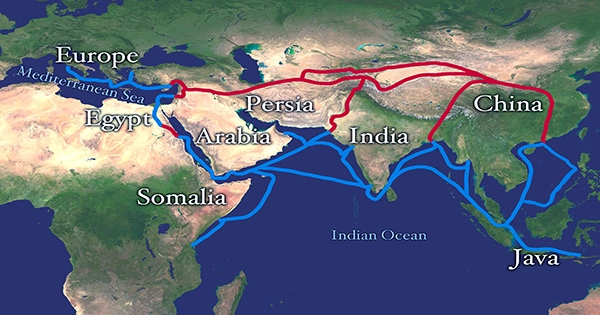Elemi resin, agarwood, and frankincense were found to be mixed in the incense burned in ancient China’s greatest Buddhist temple, the Famen Royal Temple. The result shows the role of incense in the construction of trade routes to and from China, as all are native to places hundreds of kilometers distant. Without modern sewage facilities and relying on the work of animals who were not recognized for their potty training, society valued pleasing but strong odors. Incense became a popular product for long-distance trade because it was so valuable for its weight.
The renowned Silk Road connecting China and the Middle East might have just as easily been termed the Incense Road. Trade routes facilitated the spread of something even more precious – ideas – by linking civilizations together, and so the modern world was born. While the historical significance of incense is documented, the exact nature of the smells has remained a mystery. In the Proceedings of the National Academy of Sciences, the chemical makeup of incense from perhaps China’s most important Buddhist Temple has been recreated and explained. Following the recent reproduction of the perfume Cleopatra used to enchant Roman emperors, smell archaeology appears to have arrived.
Incense has been commonly utilized in China for at least 2,200 years, according to historical documents. For much of that period, native species components were utilised, particularly fragrant thoroughwort, lily magnolia, and mugwort, according to the report. Books and medicinal prescriptions began to mention to incense brought from Arabia, India, and probably Africa by the time of the Western and Eastern Han dynasties (202 BCE-220 CE). We may estimate what these were, but finding samples for accurate examination has been difficult, so the finds in the Famen Temple’s forecourt are noteworthy.
The temple sits in Xi’an, in central China, and is a major stopover on the China-Arabia overland trade routes. It’s unknown when the temple was established, although it may have been between 386 and 534 CE, and it contained four of Buddha’s fingerbones. Despite the fact that the great majority of original relics across various religions are very doubtful, Chinese officials say that the fourth finger is truly Buddha’s. The temple was regarded highly by China’s rulers at the time, allowing it to purchase enormous quantities of the best incense.
The temple was rebuilt during the Ming Dynasty, but when a pagoda built as part of the reconstruction fell in 1981, it prompted archaeological digs that uncovered more old rooms. The archaeologists also discovered containers packed with aromatic chemicals that were assumed to date from 499 to 532 CE, three of which they treated to mass spectrometry, Fourier-transform infrared spectroscopy, and pyrolysis.
Two of the samples had Elemi resin and agarwood in them, while the other had agarwood and frankincense in it. As a result, the fragrances are the first evidence of Hexiang, or the mingling of various incenses. All three elements must have traveled long distances to reach the temple, arriving from sites nearly as far apart as their final destination. Agarwood is native to India and Southeast Asia and was likely brought by water. Frankincense came from southern Arabia and the horn of Africa, most likely along the Silk Road. Elemi is now mostly obtained from Africa, but some Burseraceae and Canarium tree species that produce it may also be found in southern China and the Philippines. However, the authors were unable to determine the Elemi variety and hence its origins.
















